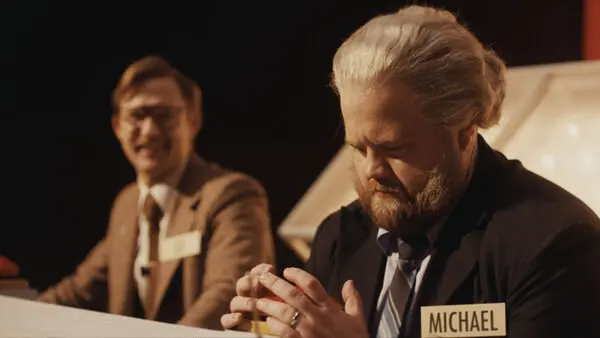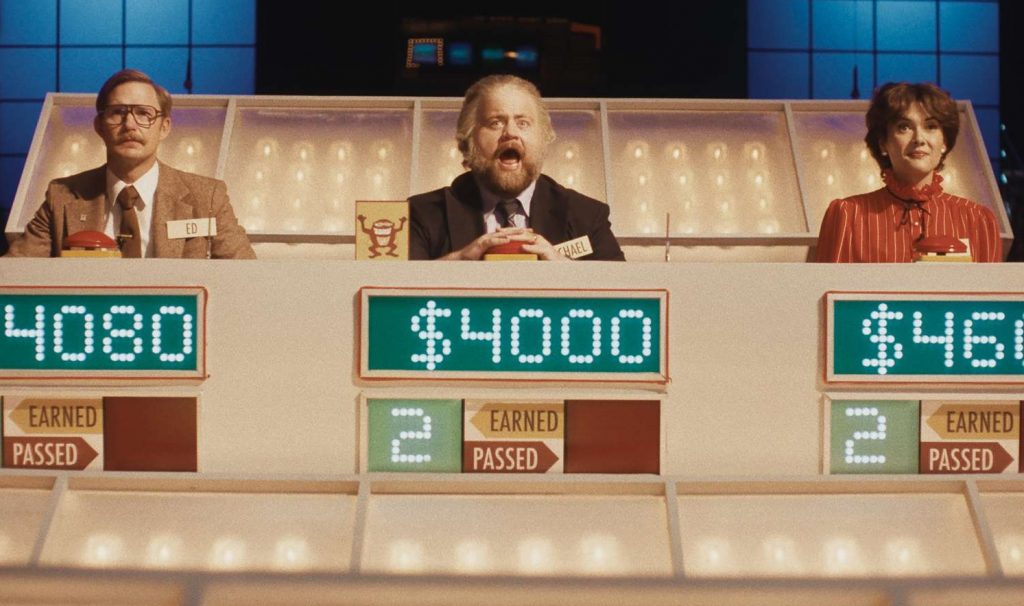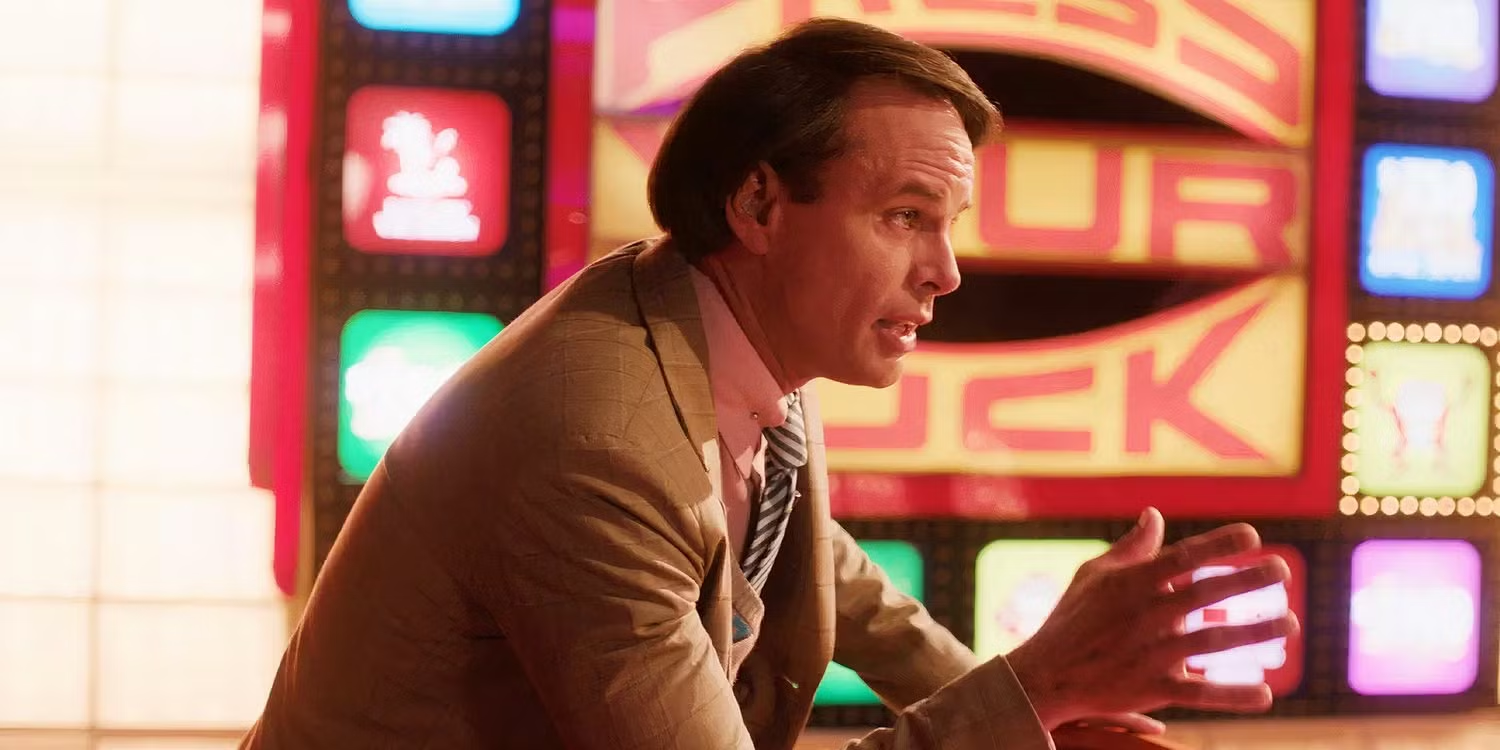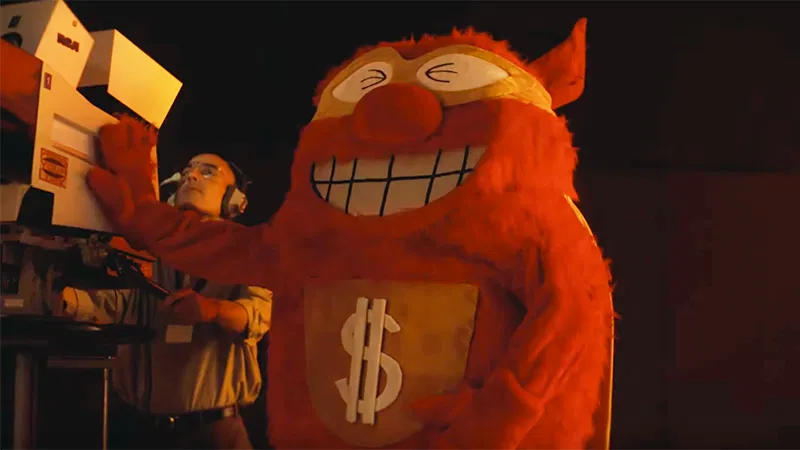
Review: The Luckiest Man In America (2025)
Christian Carrion reviews the hotly-anticipated dramatization of the man who broke Press Your Luck.
My love of Press Your Luck is a matter of public record. As I’ve mentioned on my podcast many times, and as I’ve recounted in several interviews, the show, hosted by Peter Tomarken and starring the Whammy, is the origin point of my massive adoration for the game show genre. I grew up watching the show on the USA Network, back when reruns of games like Press Your Luck, Pyramid, and Sale of the Century made up the majority of the channel’s daytime schedule. I used to practice smiling like Peter. My dad, who worked overnight at a copy shop to make ends meet when I was younger, made me a custom school notebook, laminated and adorned with screengrabs of the show, which was playing several times a day on GSN at this point. Press Your Luck is why I love game shows.
This review, however, comes with no disclaimers. I don’t feel the pull of any sort of bias that would influence me to give The Luckiest Man in America a 10 out of 10 just because it’s my favorite game show in movie form. With a matured appreciation for the entertainment we consume comes an understanding of what makes it go. The Luckiest Man in America was never going to be a pitch-perfect recreation of the infamous 1984 episodes of Press Your Luck wherein we see Michael Larson, the most famous shifty ice-cream truck driver in television since the Jolly Olly Man, take the show’s iconic board for a ride, knowledge of its inner workings in tow. We weren’t going to see 2-12-1-9-4, the section of one of the pseudo-random light patterns that was explained in fine detail in the essential GSN documentary Big Bucks: The Press Your Luck Scandal. Creative liberties in the interest of consolidating the narrative into a more easily digestible product were expected, and rightfully so.
To the uninitiated, game show fans are detail-oriented in a way that may seem esoteric, pedantic—even, dare I say, obsessive. Which color palette was best suited for the set of The Price is Right? What layout did the Wheel of Fortune use during the eponymous show’s 1987 Big Month of Cash? What typeface is used on the score displays of The Newlywed Game? There are places in our strange little circle where you are free to register your opinion on hot-button topics such as these. If you ignore that warning and choose to delve into the Internet game show fandom rabbit hole, you will no doubt see similar opinions regarding this film written by fans for whom no change is insignificant. The score displays are the wrong font! They didn’t show the second question round! They used the Price is Right “losing horns” as the Whammy sound! This movie is terrible! I don’t care about any of that. I just wanted to see a decent film treatment of a fascinating story concerning my favorite TV show. Did The Luckiest Man in America deliver? Eh, kinda.

The Luckiest Man in America tells a version of the story of what went down in Studio 33 at CBS Television City in Los Angeles on May 19, 1984 during a taping of Press Your Luck. Obsessive PYL fan Michael Larson (Paul Walter Hauser)—armed with a ceramic Whammy plate he made at home as a gift, as well as a false name for reasons explained way late in the film—drives his ice cream truck through the desert to Hollywood and auditions to be a contestant on the show. While several staffers express their concerns about Michael’s apparently latent creepiness, the producer, Bill Carruthers—sensing an opportunity to make some interesting TV—overrules the dissenting voices and fast-tracks Michael to the show as a contestant. It’s in this position that Michael, having learned to predict the seemingly indiscriminate light that jumps around the board, does his damage: in total, over $110,000 in cash and prizes, easily tripling the show’s previous high score.
In this film, Michael is apparently a criminal. In an effort to find out how he’s playing the game so well, the CBS crew searches his ice cream truck, calls his references, audits his collection of VHS tapes, exposes his failed Ponzi scheme, and uses other nefarious tactics to make Michael Larson the bad guy. This creative decision takes, in my opinion, the more interesting element of this story—a working-class dude exploiting a gamed system to his financial gain, playing against the house or the show or the network or whatever—and renders it moot. Of course he’s cheating, he’s a cheat, right? It’s a flawed, cynical, and factually inaccurate appraisal of Michael’s achievement, bolstered by the film’s decision to adorn its narrative with textbook film drama elements.

A lot of the electricity of the original episodes of Press Your Luck, available for viewing all over YouTube, comes from the reactions of the host and the audience as Michael spins again and again and again and again. Host Peter Tomarken, truly clueless as to how Michael keeps hitting that damn Big Bucks square, is taken on a whirlwind tour of emotions, from tense to thrilled to impatient to incredulous, as the money piles up beyond the stratosphere. The sound of the audience cheering, whooping, encouraging Michael throughout his record-breaking game, gives the episodes an air of cultural insurrection not unlike the vibe at a good punk show. This is an energy that is no doubt hard to duplicate with a rigid script and less room for improvisation. The film’s literal sounds of electricity and pregnant silence, however, don’t do well to communicate the true exhilaration of Michael’s feat. For a film about “the most exciting game of” these contestants’ “lives”, it was rather muted.
The main conceit of Michael’s performance—his action on the game board—is quickly pushed to the side in favor of behind-the-scenes drama that was not very well-scripted, nor engaging enough for me to care about any of the characters. Michael’s game, for the purposes of the movie, is broken up into several segments, at the ends of which the contestants and staff roam about the stage, use the restroom, fix their makeup, and talk shit about Michael, among other activities. The director seemed to be going for a more episodic hero arc comparable to current-era Jeopardy, which I get in terms of relating to current audiences—but the inflation of that emotional bubble, and its subsequent pop when Michael hits the $100,000 mark and passes his spins to his opponent, were sorely missed.

I would’ve had an easier time digesting the newly-added theatrics if they didn’t play out in such a clunky fashion. The script was as subtle as a boat fire. The writers clearly didn’t trust their audience to follow along. The film, as a result, falls into the territory of telling its viewers exactly why each character is there, what they want, and why we should care for them. At one point in the film, Michael stumbles onto the set of a talk show that’s taping in the adjacent studio. The Carson-esque host (played by Johnny Knoxville) invites Michael to sit down on set and tell his entire backstory word for word. This tactic, along with the surprise in-studio phone call during Michael’s game from his wife during which we learn that his marriage is in trouble (because of course it is), made my eyes roll. I would have appreciated the opportunity to figure out the dynamics of these emotionally complex characters instead of being hit upside the head with that information.
It’s hard to feel totally disappointed by The Luckiest Man in America, however. The synth-driven soundtrack by John Carroll Kirby is phenomenal, and hearkens back to television production music of the early 1980s. The set of the film, a truly stunning recreation of the 1983 Ed Flesh-designed set, was a thrill to see. Walter Goggins plays a great host of that period, with his glad-handing and general Gus Glitz game show grease. Paul Walter Hauser’s performane as Michael Larson was quirky and entertaining. The film was clearly assembled by people who care for the genre and the interesting stories that have been woven in its context.
They tried to Slumdog Millionaire it, though, and that vibe just doesn’t fit the nature of the story. A guy justifiably beating the shit out of a system designed to capture our attention and make us buy dishwashers, and then leaving it in the network’s lap to untangle, would have played well. To see that aspect of the story tacked on so haphazardly, though, felt like a bit of a Whammy. While the film was fun enough, the episodes of the show themselves, as well as the companion GSN documentary, are still the definitive method of experiencing this tale.


